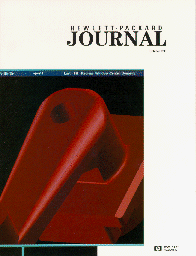|

There's a good chance that many of the mechanical parts of the products
you use, such as your car or your office printer, began their existence as
solid models in a 3D computer-aided design (CAD) system. 3D solid modeling
systems provide geometric models that can be translated into instructions for
rapid part prototyping, injection moldmaking, or numerically controlled machine
tool operation. Such systems, both commercially available and manufacturer-proprietary,
are now undergoing rapid evolution, and mechanical designers are enjoying unprecedented
and rapidly increasing productivity. However, most current systems are still
history-based, meaning that if the designer doesn't have in-depth knowledge
of the underlying solid modeling technology or doesn't thoroughly understand
the history of the design, even seemingly trivial changes made to the model
may have unanticipated side effects. In contrast, HP Precision Engineering
SolidDesigner (PE/SolidDesigner) is an advanced 3D solid modeling CAD system
based on dynamic modeling technology. As explained in the article on page 6, dynamic modeling removes any dependencies on history and eliminates the need to anticipate future changes,
so that local geometry and topology changes can be made easily. When a change
is made, a tool body is created and then transformed to the appropriate position.
A Boolean operation between the original model and the tool body results in
the desired change. The HP PE/SolidDesigner user interface (page 14)
is designed to make the system easy to use for both experts and first-time
or occasional users. Internally, action routines representing commands interact
with the user interface objects through a "personality"; this architecture
makes it easy to change the user interface without changing the command syntax.
To a computer, a 3D solid model is a highly complex data structure. HP PE/SolidDesigner's
data structure manager (page 51), which has many of the characteristics of an object-oriented database, supports the data manipulation requirements of the solid modeling process, including
the ability to slice the model into manageable packages that can be sent around
the world, for example to subcontractors. Because HP business partners and
customers may use other solid modeling systems instead of or in addition to
HP PE/SolidDesigner, HP participates in international data exchange standardization
efforts, most notably STEP, the Standard for the Exchange of Product Model
Data. HP PE/SolidDesigner can import and export both surface and solid STEP
data files. It can also import IGES (Initial Graphics Exchange Standard) surface
and wireframe data files, and can import data files from its predecessor, the
HP PE/ME30 3D CAD system. Data exchange is the subject of the article on page
35. Freeform surfaces
are often needed in solid model creation, and HP PE/SolidDesigner provides
two methods for creating them: blending, or edge rounding, and lofting. The
article on page 24 describes
the many subtleties of the sophisticated algorithm used for variable-radius
blending. Complex combinations of convex and concave edges are blended predictably
and reliably-a difficult design challenge. The article on page 61
tells how the product's geometric kernel implements lofting using a single-data-type
geometric interface and a hybrid, multiple-data-type internal implementation.
The lofting functionality features a clever analytic surface detection algorithm.
The Boolean operations used to effect model modifications are implemented in
the system's topology kernel, called the "Boolean engine." The article on page
74 explains the Boolean
engine's complex algorithms in simple terms. Much of HP PE/SolidDesigner is
written in the Common Lisp programming language, which is also included in
HP PE/SolidDesigner as an extension and customization language for users (page
69 ).
The microwave signals that ride our airwaves today are likely to have much
wider bandwidths than those of yesterday. Spread spectrum techniques, increasingly
used in radar systems and satellite and terrestrial communications systems,
trade increased bandwidth for benefits such as increased noise immunity, lower
power density, or increased security. The spectrum analyzers traditionally
used to analyze microwave signals aren't up to the job of extracting all of
the information from modern microwave signals because they don't have the bandwidth
and don't reveal pulse, phase, or time-varying behavior. The HP 70910A wide-bandwidth
receiver is designed to fill this need. It combines the attributes of a microwave
receiver, including wider bandwidths and demodulation capability, with the
strengths of a microwave spectrum analyzer, which include low internal noise,
amplitude measurement accuracy, and wide frequency tuning with synthesizer
accuracy and fine resolution. The HP 70910A wide-bandwidth receiver consists
of two components: the HP 70910A RF module and the HP 70911A IF module. The
IF module provides the functions usually associated with a microwave receiver,
such as intermediate frequency (IF) bandwidths from 10 to 100 MHz and pulse
detection. It also offers options for FM demodulation, 70-megahertz IF output,
and I-Q output (the type of modulation used in digital communications systems).
The I-Q option can be used with a dual-channel vector signal analyzer such
as the HP 89410A to extend the analyzer's bandwidth and frequency range. The
two most common HP 70910A configurations operate over a frequency range of
100 hertz to 26.5 gigahertz. The design of the HP 70910A wide-bandwidth receiver
and that of its RF module are described in the article on page 80.
The IF module design, featuring variable-bandwidth, synchronous filters with
tapped-capacitor, varactor-tuned resonators, is described in the article on
page 89.
A color printer is typically used for a variety of documents, from simple
black text pages that take a few seconds to print to color graphics pages that
take several minutes. If you're the printer's designer, how do you measure
how many pages per minute it will print so that you can judge the effects of
design changes on a user's perception of its speed? The designers of the HP
DeskJet 1600C printer considered the simple average and the simple weighted
average, but rejected them in favor of the log weighted average. The article
on page 104 tells why.
R.P. Dolan
Senior Editor
|
|